![]()
![]()
![]()
Use LEFT and RIGHT arrow keys to navigate between flashcards;
Use UP and DOWN arrow keys to flip the card;
H to show hint;
A reads text to speech;
47 Cards in this Set
- Front
- Back
|
Cerebrospinal fluid fluctuation of
|
A description of the hypothesized action of CSF with regard to the craniosacral mechanism
|
|
|
Core link
|
The connection of the spinal dura mater from the occiput at the foramen magnum to the sacrum.
It coordinates the synchronous motion of these two structures |
|
|
Cranial rhythmic impulse (CRI)
|
1. A palpable, rhythmic fluctuation believed to be synchronous with the primary respiratory mechanism.
2. Term coined by John Woods, DO, and Rachel Woods, DO |
|
|
Craniosacral mechanism
|
1. A term used to refer to the anatomical connection between the occiput and the sacrum by the spinal dura mater.
2. A term coined by William G. Sutherland, DO. See also extension, craniosacral extension and flexion, craniosacral flexion |
|
|
Craniosacral extension
|
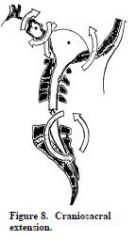
motion occurring during the cranial rhythmic impulse when the sphenobasilar symphysis descends and sacral base moves anteriorly. (Fig. 8)
|
|
|
Extrinsic corrective forces
|
Treatment forces external to the patient that may include operator effort, effect of gravity, mechanical tables, etc.
See also intrinsic corrective forces. |
|
|
Craniosacral flexion
|
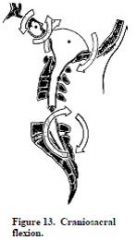
motion occurring during the cranial rhythmic impulse, when the sphenobasilar symphysis ascends and the sacral base moves posteriorly. (Fig. 13)
|
|
|
Intrinsic corrective forces
|
Voluntary or involuntary forces from within the patient that assist in the manipulative treatment process.
See also extrinsic corrective forces. |
|
|
Ligamentous: Articular strain
|
any somatic dysfunction resulting in abnormal ligamentous tension or strain.
See also osteopathic manipulative treatment, ligamentous articular strain technique |
|
|
Ligamentous: Articular strain technique (LAS),
|
1. A manipulative technique in which the goal of treatment is to balance the tension in opposing ligaments where there is abnormal tension present.
2. A set of myofascial release techniques described by Howard Lippincott, DO, and Rebecca Lippincott, DO. 3. Title of reference work by Conrad Speece, DO, and William Thomas Crow, DO. |
|
|
Ligamentous: Strain
|
motion and/or positional asymmetry associated with elastic deformation of connective tissue (fascia, ligament, membrane).
|
|
|
Inherent motion
|
spontaneous motion of every cell, organ, system and their component units within the body.
|
|
|
Balanced ligamentous tension (BLT)
|
1. According to Sutherland’s model, all the joints in the body are balanced ligamentous articular mechanisms.
The ligaments provide proprioceptive information that guides the muscle response for positioning the joint and the ligaments themselves guide the motion of the articular components. (Foundations) 2. First described in “Osteopathic Technique of William G. Sutherland”, that was published in the 1949 Year Book of Academy of Applied Osteopathy. See also ligamentous articular strain. |
|
|
Compression of the fourth ventricle (CV-4)
|
a cranial technique in which the lateral angles of the occipital squama are manually approximated slightly exaggerating the posterior convexity of the occiput and taking the cranium into sustained extension.
|
|
|
Exaggeration method
|
an osteopathic treatment strategy by which the dysfunctional component is carried away from the restrictive barrier and beyond the range of oluntary motion to a point of palpably increased tension
|
|
|
Exaggeration technique
|
an indirect procedure that involves carrying the dysfunctional part away from the restrictive barrier, then applying a high velocity/low amplitude force in the same direction.
|
|
|
Osteopathy in the Cranial Field (OCF)
|
1. A system of diagnosis and treatment by an osteopathic practitioner using the primary respiratory mechanism and balanced membranous tension.
See also primary respiratory mechanism. 2. Refers to the system of diagnosis and treatment first described by William G. Sutherland, DO. 3. Title of reference work by Harold Magoun, Sr, DO. |
|
|
V-spread
|
technique using forces transmitted across the diameter of the skull to accomplish sutural gapping.
|
|
|
Plagiocephaly
|
An asymmetric condition of the head.
|
|
|
Primary machinery of life
|
The neuromusculoskeletal system.
A term used to denote that body parts act together to transmit and modify force and motion through which man acts out his life. This integration is achieved via the central nervous system acting in response to continued sensory input from the internal and external environment |
|
|
Primary respiratory mechanism (part 1 of 2)
|
1. A conceptual model that describes a process involving five interactive, involuntary functions:
(1). The FLUCTUATION of the CSF (2). The inherent MOTILITY of the brain and spinal cord. (3). The MOBILITY of the intracranial and intraspinal membranes and the function of the Reciprical Tension Membrane (RTM) (4). The articular MOBILITY of the cranial bones. (5). THE involuntary MOBILITY of the sacrum between the ilia (pelvic bones) that is interdependent with the motion at the sphenobasilar synchondrosis. (a Fluctuation, a Motility, and 3 Mobility's) This mechanism refers to the presumed inherent (primordial) driving mechanism of internal respiration as opposed to the cycle of diaphragmatic respiration (inhalation and exhalation). It further refers to the innate interconnected movement of every tissue and structure of the body. Optimal health promotes optimal function and the inherent function of this interdependent movement can be negatively altered by trauma, disease states or other pathology. |
|
|
Primary respiratory mechanism (part 2 of 2)
|
2. This mechanism was first described by William G. Sutherland, DO, and is thought to affect cellular respiration and other body processes. (PPT - implies an integrated machine, each part in working relationship to every other part)
In the original definition, the following descriptions were given: primary - because it is directly concerned with the internal tissue respiration of the central nervous system. (PPT - refers to being first in importance in relation to the thoracic respiration being secondary) respiratory - because it further concerns the physiological function of the interchange of fluids necessary for normal metabolism and biochemistry, not only of the central nervous system, but also of all body cells. (PPT - refers to exchange of gases and other metabolites at the cellular level.) mechanism - because all the constituent parts work together as a unit carrying out this fundamental physiology. See also osteopathic manipulative treatment (OMT), osteopathy in the cranial field |
|
|
Reciprocal tension membrane
|
The intracranial and spinal dural membrane including the falx cerebri, falx cerebelli, tentorium and spinal dura
|
|
|
Scaphocephaly
|
Also called scaphoid head or hatchet head, it is a transverse compression of the cranium with a resultant mid-sagittal ridge.
|
|
|
Sphenobasilar synchondrosis (symphysis), somatic dysfunctions of
|
any of a group of somatic dysfunctions involving primarily the interrelationship between the basilar portion of the sphenoid (basisphenoid) and the basilar portion of the occiput (basiocciput).
The abbreviation, SBS, is often used in reporting the following somatic dysfunctions: 1. compression 2. extension 3. flexion 4. lateral strain 5. sidebending-rotation 6. torsion 7. vertical strain |
|
|
SBS compression
|
somatic dysfunction in which the basisphenoid and basiocciput are held forced together significantly limiting SBS motion.
|
|
|
SBS extension
|
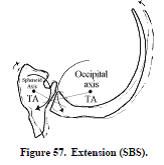
sphenoid and occiput have rotated in opposite directions around parallel transverse axes;
the basiocciput and basisphenoid are both inferior in SBS extension with a decrease in the dorsal convexity between these two bones. |
|
|
SBS flexion
|
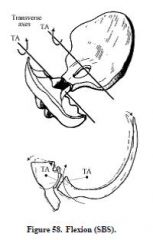
sphenoid and occiput have rotated in opposite directions around parallel transverse axes;
the basiocciput and basisphenoid are both superior in SBS extension with an increase in the dorsal convexity between these two bones. |
|
|
SBS Lateral strain
|
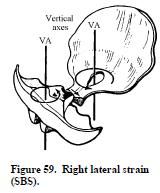
sphenoid and occiput have rotated in the same direction around parallel vertical axes.
Lateral strains of the SBS are named for the position of the basisphenoid, right or left. |
|
|
SBS Sidebending-rotation
|
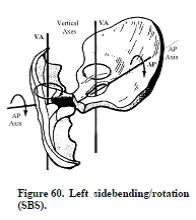
sphenoid and occiput have rotated in opposite directions around parallel vertical axesand rotate in the same direction around an A-P axis.
SBS sidebending-rotations are named for the convexity, right or left. |
|
|
SBS Torsion
|

sphenoid and occiput have rotated in opposite directions around an anterior-posterior (A-P) axis.
SBS torsions are named for the high greater wing of the sphenoid, right or left |
|
|
SBS Vertical strain
|
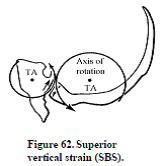
sphenoid and occiput have rotated in the same direction around parallel transverse axes.
Vertical strains of the SBS are named for the position of the basisphenoid, superior or inferior. |
|
|
Still point
|
term used to identify and describe the temporary cessation of the rhythmic motion of the primary respiratory mechanism.
It may occur during osteopathic manipulative treatment when a point of balanced membranous or ligamentous tension is achieved. |
|
|
Traube-Herring-Mayer wave
|
An oscillation that has been measured in association with blood pressure, heart rate, cardiac contractility, pulmonary blood flow, cerebral blood flow and movement of the cerebrospinal fluid, and peripheral blood flow including venous volume and thermal regulation.
This whole-body phenomenon, which exhibits a rate typically slightly less than and independent of respiration, bears a striking resemblance to the primary respiratory mechanism. |
|
|
Articulatory treatment system ART
|
a low velocity/moderate to high amplitude technique where a joint is carried through its full motion with the therapeutic goal of increased range of movement.
The activating force is either a repetitive springing motion or repetitive concentric movement of the joint through the restrictive barrier. |
|
|
Complete motor asymmetry
|
Asymmetry of palpatory responses to all regional motion inputs including rotation, translation and active respiration.
|
|
|
Dupuytren contracture
|
shortening, thickening and fibrosis of the palmar fascia, producing a flexion deformity of a finger
|
|
|
Kinesthesia
|
The sense by which muscular motion, weight, position, etc., are perceived.
|
|
|
Kinesthetic
|
Pertaining to kinesthesia
|
|
|
Kinetics
|
The body of knowledge that deals with the effects of forces that produce or modify body motion
|
|
|
Kneading
|
A soft tissue technique that utilizes an intermittent force applied perpendicular to the long axis of the muscle.
|
|
|
Isokinetic contraction
|
1. A concentric contraction against resistance in which the angular change of joint motion is at the same rate.
2. The counterforce is less than the patient force. |
|
|
Isokinetic exercise
|
Exercise using a constant speed of movement of the body part.
|
|
|
Isotonic contraction
|
1. A form of concentric contraction in which a constant force is applied.
2. Operator force less than patient force. |
|
|
NMM-OMM
|
Osteopathic neuromusculoskeletal medicine certification is granted by the American Osteopathic Association through the American Osteopathic Board of Neuromusculoskeletal Medicine.
First granted in 1999. |
|
|
Springing technique
|
a low velocity/ moderate amplitude technique where the restrictive barrier is engaged repeatedly to produce an increased freedom of motion
|
|
|
Toggle technique
|
short lever technique using compression and shearing forces.
|

